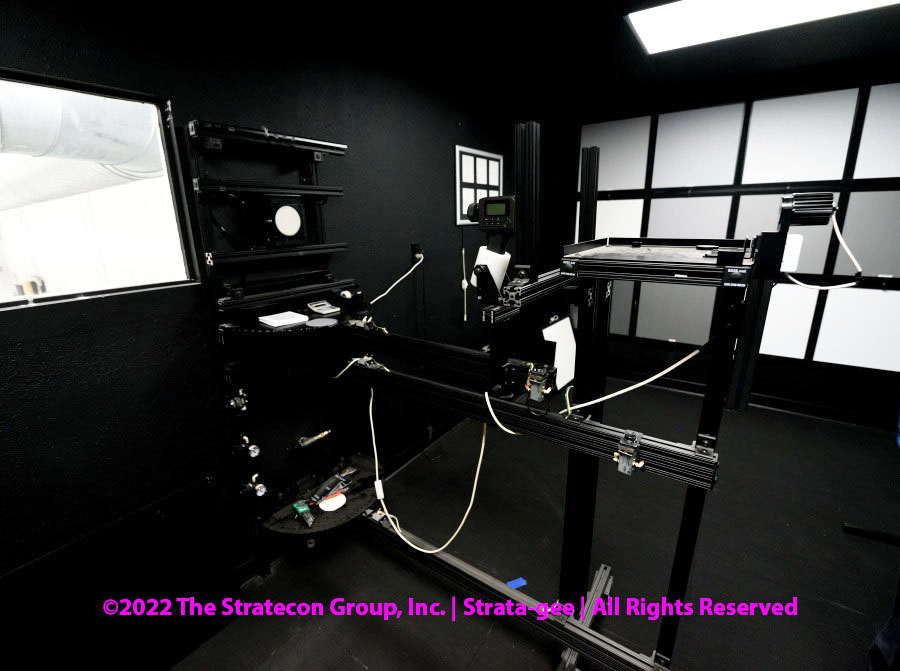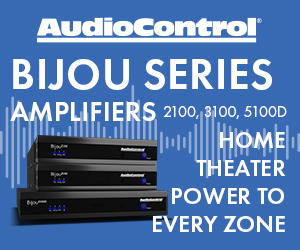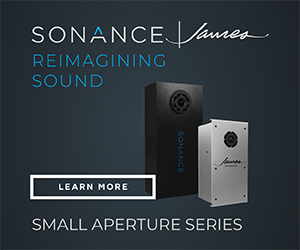
The only way to truly know the performance of a screen is through a detailed and rigorous testing routine. For that, you need a sophisticated testing laboratory space with specialized testing gear – known as an imaging lab. Not all screen companies have one, but Draper’s TecVision does and the company graciously treated me – and via this story, you – for a visit to the impressive TecVision Imaging Lab.
See the Draper Inc.’s TecVision Imaging Lab
I first got a glimpse of the TecVision Lighting Lab when late last year I had the opportunity to visit Draper, a leading shading and screen manufacturer based in central Indiana. The company, which has an extensive 400,000 sq. ft. campus of office and production buildings, includes one that houses a unique space known as the TecVision Lighting Lab.
TecVision is Draper, Inc.’s line of high-performance engineered screens. The company makes a full line of screens, available in white, gray, and an ALR – ambient light rejection series. TecVision features eleven proprietary screen formulations, all of which are certified by the Imaging Science Foundation.
Want That Tasty Screen Super-Sized?
During my visit last year, I actually had the opportunity to watch TecVision screens being manufactured by a massive room-sized automated system in which their custom screen formulations are sprayed onto a high-tech backing material. They can make a completely seamless screen in any size up to an astonishing 23′ high by 69′ wide.
More recently, I received an invitation to see the Lighting Lab in action and it was an opportunity that I couldn’t pass up. Hosting me for this demonstration was Scott Blakenship who heads up TecVision, as well as several other technical departments for Draper – and Joseph Burke, AV Consultant Relations and AVMS Projects. Like Blakenship, Burke is an expert on screens and perhaps more importantly, a specialist in helping clients/dealers/integrators with the planning, designing, and installation of projects involving TecVision screens.

Conducts More Than 30 Tests on TecVision Screens
TecVision is a premium product, and as such, it behooves the company to be able to precisely test key attributes of its various products and those of competitors. The company conducts more than 30 independent highly precise testing routines in its Lighting Lab.
The first surprising thing to know is that Draper literally built this entire testing space, including the key testing fixture that precisely measures screen material. That precision testing fixture was built in-house in Draper’s machine shop and is an aluminum structure coupled with a vacuum system to precisely hold test materials and to accurately set and hold a light source and a light meter, each on its own movable/indexable arm. The reference-grade indexing system is for precisely setting viewing/testing angles. Even that index system uses a vacuum lock to make sure the angle is set and held exactly.
Testing ‘Gain’ – A Key Stat
We didn’t have time to perform 30+ tests, but we went through a few. First up, I was able to watch Blankenship demonstrate the process of measuring gain – a key stat for screens.
You might think something called a “Lighting Lab” would be a nice bright space. On the contrary, these labs are dark places – pitch black, really – featuring black walls, mostly black equipment & fixtures, with occasional glimpses of gray and white spaces. Yep, these lab techs do their best work…in the dark.
See more photos in a slideshow of my visit to Draper’s TecVision Lighting Lab
Ascending to the Somewhat Mystical Imaging Lab
You climb a set of stairs to get to the Imaging Lab, which was built in a former general office that had been moved. Just past the entry door, you are standing in an office area with two workstations. This area includes a unique filing system where the company keeps samples of all of the production runs of their screens along with their test results. Draper keeps this information on file in perpetuity (yep, forever).

Just next to this is a small window that looks out into the screen production room. This window can be covered up during testing if necessary. At the mid-point of the room is the main testing fixture where reference samples and product samples, can be tested.

Test Gear Used in TecVision Imaging Lab
| Characteristic | Standard/Method | Equipment |
| Gain | SMPTE RP 94-2000/Draper test method | Konica Minolta LS 100, Avian reference standard, 3W LED light, Draper Custom Gain Test Fixture |
| Viewing Angle | Calculated using Gain data | Konica Minolta LS 100, Avian reference standard, 3W LED light, Draper Custom Gain Test Fixture |
| Gloss | ASTM D 523 | BYK Micro-Gloss 60° Gloss Meter |
| Contrast Ratio | InfoComm 3M-2011 DS1 | Any ISF recommended projector, Konica Minolta LS 100 |
| Color Uniformity | Draper Test Method | DataColor Check 3 Spectrophotometer |
| Color Shift | Draper Test Method | DataColor Check 3 Spectrophotometer |
| Ambient Light Rejection (ALR) | Draper Test Method | Konica Minolta LS 100, Avian reference standard, 3W LED light, Draper Custom Gain Test Fixture |

Think All Screens are Alike? Think Again
At the far end of the room is a panel of twelve screen sections mounted on the wall. This is the entire TecVision line of screens. Above this is a rectangular light panel washing light down onto the screen samples. Near that end of the room on the wall on the left is a light panel in the shape of a window that can also be turned on to mimic light streaming in a window into the room. These light sources have a major impact on the image we see on the screen panels, but to a varying degree depending on the technology behind each individual screen sample.
See more photos in a slideshow of my visit to Draper’s TecVision Lighting Lab
Our first test is gain, which measures the degree of reflectivity of a screen material. A screen said to have a gain of “1.0” means that it reflects 100% of the light it receives. Different screens reflect more or less, depending on the attribute desired in the space and the system designed around it.

Methodically Testing, First a Reference, Then an Actual Sample
For the gain test, Blankenship first mounts a card that is a reference “pure white” material. Again, the vacuum system holds the sample perfectly flat in place. Then he turns the room lights off and turns on the reference 3-watt LED light source (which is indexed and locked at 0°). With the reference light hitting the reference card, Blankenship methodically uses the light meter to take a reading first at 3½°, then 5°, and on every 5° increments to as much as 90°. This data is then entered into the computer and the reading for zero degrees is imputed.
Then the reference card is removed and replaced by the actual screen test sample – and the entire testing process is repeated. Although the process is a bit tedious, especially if you have multiple samples to test, it is highly accurate. The company says it tests all TecVision screens and if any screen tests outside of its published spec – that screen is rejected. They allow NO margin for error on the TecVision line and hold super tight tolerances on the standard Draper screens as well.

So we measure in either in candelas per meter square or lumens per meter square, it doesn’t really matter. It’s still going to result in a ratio which is what you need to use. That’s how we populate our gain curves that we publish in all of our literature. I would measure all my angles and record the meter measurement.
Scott Blankenship, Draper’s Department Head for TecVision
Testing Ambient Light Rejection Efficiency
The same testing fixture is also used to test ambient light rejection (ALR). ALR screens employ a certain kind of screen formulation that has special reflective properties to redirect off-axis light – the ambient light in a room as opposed to the light from the projector – away from the viewer’s eyes. This means you will perceive more of the direct projected light, as opposed to the inherent ambient light in the room. This property of rejecting ambient light can be tested, and TecVision’s Imaging Lab regularly tests the rejection properties of its and competitors’ screens.
See more photos in a slideshow of my visit to Draper’s TecVision Lighting Lab
Interestingly, the testing process is almost the reverse of testing gain. In this case, the light meter remains fixed at the 0° position and the light source is moved and set at the 45° angle position. The light meter measures the light at this point to show the percentage of rejection of off-axis light. More is better, so a higher rejection percentage means a better-looking screen in a room with a high ambient light level.
The Most Commonly Conducted Tests in the Imaging Lab
“So what this does is it measures how much light at 45 degrees comes back to the viewer,” Blankenship told me. “This is the measurement standard we use and it shows us the amount of ambient light that was rejected by the screen.”
In this imaging lab, the company primarily tests for gain, viewing angle, gloss, color uniformity, color shift, and ambient light rejection. In a separate testing lab, the company does more physical testing of materials, motors, and the like. It’s in that other lab where they are also testing material tensile strength, the strength of welds, and seams.

An Impressive Display of the Impact of Different Screen Models
In looking at the sample of twelve screens on the wall, I asked Joe Burke why there were twelve different screen models to consider. Simple, he said, “Because there is no perfect screen. There is no one perfect screen that works in every situation. But there is a perfect screen for every environment.”
Blankenship turned out the room lights but had an overhead light washing against all twelve screens. Then he projected the same image of a native person on all twelve screens. With the combination of the projector light hitting each screen, along with the overhead light hitting each screen – we see a dramatic difference.
I like to show this particular slide with the lights in this fashion because the image is darkened by nature. So you really see where gray screens are helping you boost your contrast. And you can really see that the white screens, especially the higher gain screens are really really washing out. The more normal white screen with a 1.0 gain is not quite as washed out. But then when you cut the lights, like Joe said earlier, if you had a purist that has a pure black room – everything looks great.
Scott Blankenship

Screens Don’t Discriminate – They Reflect Any Light Regardless of Source
Joe Burke agreed that “…in a perfect environment, the white screens are going to give you the performance of the projector. And they’re not going to manipulate or steer anything in any direction. But it has to be a perfect environment. As soon as you bring up the overhead light, instantly, we can see that everything is being affected, because the material is designed to reflect any light [both from the projector and the environment].”
See more photos in a slideshow of my visit to Draper’s TecVision Lighting Lab
So the screen experts told me that in a dedicated home theater with a fully controlled lighting environment, typically the white screens the company offers are the better options. But if we are talking about a media room with windows and other environmental lighting, the company’s gray ALR screens are almost always the better option.

There are Always Tradeoffs with Any Screen You Choose
With the gray screens, you get deeper black levels, better overall contrast, and deep colors. However, as Burke admitted as a bit of a tradeoff, “I have to accept, though, that my whites are going to be a little bit muddy.” Certainly not as brilliantly white as on the white screens.
Still, Burke notes, “But because I don’t have a reference point [another source of white to compare it to], I won’t question the whiteness of the whites.”
Factors to Consider When Picking a Screen
Burke told me that there are many factors to consider when picking a screen as, again, no single screen works in every situation. You have to consider the projector being specified, the environment of the room, the existence of any environmental light source, and finally, the client’s preference.
It was an interesting and educational day I spent with the TecVision team. It is clear that they are very serious about building a better screen and delivering a better solution for integrators and their clients.
Learn more about TecVision by visiting draperinc.com/projectorscreens/tecvision.aspx.










Very good article— very informative!
Thank you sir!